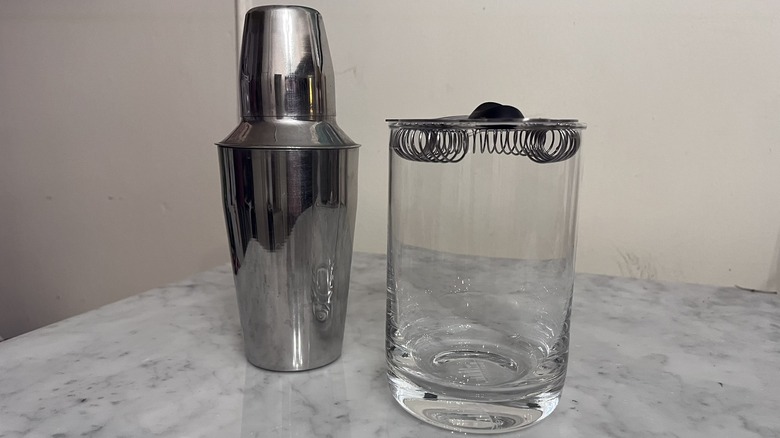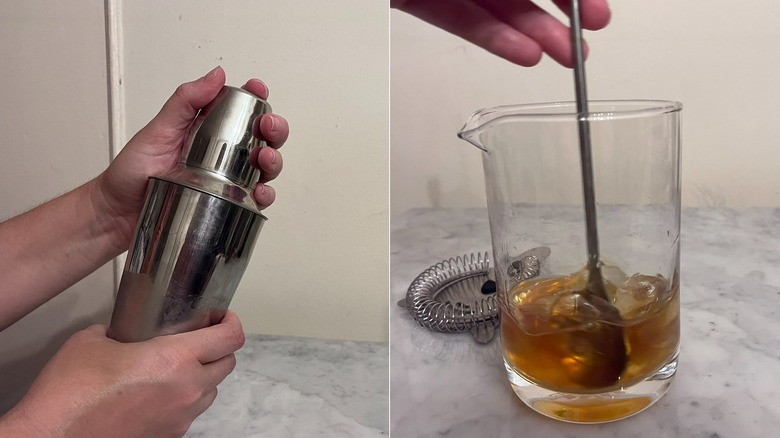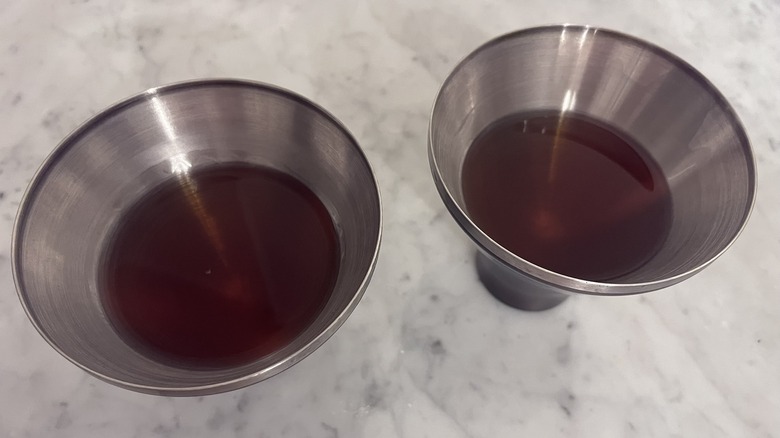Shaken Cocktail Vs Stirred: We Tried Both To Find Out If There Really Is A Difference
We may receive a commission on purchases made from links.
Even novice cocktail makers and drinkers know the phrase "shaken, not stirred," made famous by James Bond's martini order. Shaking and stirring are processes applied to making many cocktails, not just 007's booze of choice, so we decided to test if shaking or stirring a drink affects how the cocktail eventually tastes.
Two recipes appear in cocktail expert J.M. Hirsch's book "Pour Me Another" that are identical in ingredients: bourbon, sweet vermouth, and Green Chartreuse. One, called the Tipperary Cocktail #1, instructs that the cocktail be shaken; the other, called the San Martin Cocktail, is stirred. In both cases, Hirsch modified the base spirit to bourbon from the original version of the cocktails, so perhaps the nearly duplicative recipes are accidental. Regardless of intent, the discovery sparked a desire to investigate.
The terms shaken and stirred are literal; both refer to how the ingredients in a cocktail are mixed with ice. It is generally advised to shake a cocktail when it contains a component that will make the drink cloudy, such as egg whites, juices, or cream-based liqueurs like Bailey's, to help these ingredients mix together well. A Grasshopper cocktail is a well-known example of a shaken drink. The act of shaking also breaks apart the ice, causing aeration throughout the beverage and chilling the cocktail faster. Stirring is recommended for cocktails that have all clear ingredients. This doesn't necessarily mean that your drink has no color, just that nothing being used in the beverage will make it cloudy. There aren't any complex interactions to manage between ingredients in a stirred drink. Beyond martinis, other traditionally stirred drinks include Negronis and the Manhattans.
How to shake or stir a cocktail
Both cocktail recipes were followed according to the different stated preparations, with one modification. As we didn't have green Chartreuse on hand, Vegètal was swapped in each recipe.
We first assembled the Tipperary Cocktail #1, which was to be shaken per the recipe. All the ingredients were added to a cocktail shaker with about four regular-sized ice cubes. If you have yet to stock your bar cart and you don't have a cocktail shaker at home, you can substitute with any vessel that can be easily closed, such as a mason jar or a water bottle. When shaking a cocktail, prevailing advice states to shake it for no longer than 15 seconds. This gives enough time for the ice to break down and permeate the drink. We shook the cocktail holding the shaker with both hands, but the specific shaking technique can vary. The aeration caused by the ice will cause bubbles to form; when pouring the finished cocktail, we could see the bubbles doing their work in the shaken cocktail as it reached the glass.
Next, we made the San Martin Cocktail, which called for stirring. The exact same ingredients were placed into a large, sturdy container known as a mixing glass with a removable strainer; again, if you don't have a professional-grade mixing glass and/or bar spoon, any glass and long-handled spoon will work. Stirring a drink is also a quick action, though a bit longer than shaking. Experts recommend stirring a drink for about 30-45 seconds. This is enough time for the ice to dilute the beverage and balance the flavors within. Perhaps because of stirring, the stirred drink appeared distinctively lighter in color while in the mixing glass.
Shaken vs stirred: a taste test
On appearance in the glass, both cocktails look nearly identical. In the above photo, the cocktail on the left was shaken, and the one on the right was stirred.
The cocktail crafted by shaking was much more spirit-forward than the stirred version. The bourbon notes hit immediately on the first taste, with the other flavors revealing themselves with future sips as the ice melted and diluted the primary spirit. The shaken version may be preferable for drinkers who want the bourbon to be highlighted.
In contrast, the stirred cocktail went down more smoothly overall. The results lend credence to the advice to stir this particular type of cocktail. All the ingredients in Hirsch's recipe are considered clear, and upon stirring them together, the finished beverage was properly blended and easy to drink.
This does mean that, in preferring his vesper martinis shaken, James Bond is going against cocktail guidelines. You could argue that 007 is a busy man who constantly breaks the rules, and needs a faster, colder beverage to get on with saving the world.


